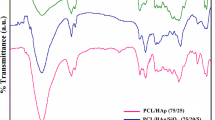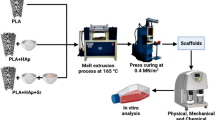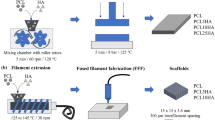Abstract
Polymer–ceramic composites are favourite candidates when aiming to replace bone tissue. We present here scaffolds made of polycaprolactone-hydroxyapatite (PCL-HAp) composites, and investigate in vitro mineralisation of the scaffolds in SBF after or without a nucleation treatment. In vitro bioactivity is enhanced by HAp incorporation as well as by nucleation treatment, as demonstrated by simulated body fluid (SBF) mineralization. Surprisingly, we obtained a hybrid interconnected organic-inorganic structure, as a result of micropore invasion by biomimetic apatite, which results in a mechanical strengthening of the material after two weeks of immersion in SBF×2. The presented scaffolds, due to their multiple qualities, are expected to be valuable supports for bone tissue engineering.











Similar content being viewed by others
References
Ciapetti G, Ambrosio L, Savarino L, Granchi D, Cenni E, Baldini N, et al. Osteoblast growth and function in porous poly ε-caprolactone matrices for bone repair: a preliminary study. Biomaterials. 2003;24:3815–24.
Hasegawa S, Neo M, Tamura J, Fujibayashi S, Takemoto M, Shikinami Y, et al. In vivo evaluation of a porous hydroxyapatite/poly-dl-lactide composite for bone tissue engineering. J Biomed Mater Res A. 2007;81A:930–8.
Shor L, Güçeri S, Wen X, Gandhi M, Sun W. Fabrication of three-dimensional polycaprolactone/hydroxyapatite tissue scaffolds and osteoblast-scaffold interactions in vitro. Biomaterials. 2007;28:5291–7.
Woo KM, Seo J, Zhang R, Ma PX. Suppression of apoptosis by enhanced protein adsorption on polymer/hydroxyapatite composite scaffolds. Biomaterials. 2007;28:2622–30.
Kokubo HK T, Sakka S, Kitsugi T, Yamamuro T. Solutions able to reproduce in vivo surface-structure changes in bioactive glass–ceramic A-W. J Biomed Mat Res. 1990;24:721–34.
Kokubo T, Takadama H. How useful is SBF in predicting in vivo bone bioactivity? Biomaterials. 2006;27:2907–15.
Oliveira AL, Mano JF, Reis RL. Nature-inspired calcium phosphate coatings: present status and novel advances in the science of mimicry. Curr Opin Solid State Mater Sci. 2003;7:309–18.
Kawashita M, Nakao M, Minoda M, Kim HM, Beppu T, Miyamoto T, et al. Apatite-forming ability of carboxyl group-containing polymer gels in a simulated body fluid. Biomaterials. 2003;24:2477–84.
Kim H-M, Himeno T, Kokubo T, Nakamura T. Process and kinetics of bonelike apatite formation on sintered hydroxyapatite in a simulated body fluid. Biomaterials. 2005;26:4366–73.
Lickorish D, Ramshaw JA, Werkmeister JA, Glattauer V, Howlett CR. Collagen-hydroxyapatite composite prepared by biomimetic process. J Biomed Mater Res A. 2004;68A:19–27.
You C, Miyazaki T, Ishida E, Ashizuka M, Ohtsuki C, Tanihara M. Fabrication of poly(vinyl alcohol)-apatite hybrids through biomimetic process. J Eur Ceram Soc. 2007;27:1585–8.
Kim H-W, Kim H-E, Salih V. Stimulation of osteoblast responses to biomimetic nanocomposites of gelatin-hydroxyapatite for tissue engineering scaffolds. Biomaterials. 2005;26:5221–30.
Chen Y, Mak AFT, Wang M, Li J, Wong MS. PLLA scaffolds with biomimetic apatite coating and biomimetic apatite/collagen composite coating to enhance osteoblast-like cells attachment and activity. Surf Coat Technol. 2006;201:575–80.
Azevedo HS, Leonor IB, Alves CM, Reis RL. Incorporation of proteins and enzymes at different stages of the preparation of calcium phosphate coatings on a degradable substrate by a biomimetic methodology. Mater Sci Eng C. 2005;25:169–79.
Cüneyt Tas A. Synthesis of biomimetic Ca-hydroxyapatite powders at 37°C in synthetic body fluids. Biomaterials. 2000;21:1429–38.
Landi E, Tampieri A, Celotti G, Langenati R, Sandri M, Sprio S. Nucleation of biomimetic apatite in synthetic body fluids: dense and porous scaffold development. Biomaterials. 2005;26:2835–45.
Kim SS, Park MS, Gwak SJ, Choi CY, Kim BS. Accelerated bonelike apatite growth on porous polymer/ceramic composite scaffolds in vitro. Tissue Eng. 2006;12:2997–3006.
Stoch A, Jastrzebski W, Brozek A, Stoch J, Szaraniec J, Trybalska B, et al. FTIR absorption-reflection study of biomimetic growth of phosphates on titanium implants. J Mol Struct. 2000;555:375–82.
Müller L, Müller FA. Preparation of SBF with different content and its influence on the composition of biomimetic apatites. Acta Biomater. 2006;2:181–9.
Müller L, Conforto E, Caillard D, Müller FA. Biomimetic apatite coatings—carbonate substitution and preferred growth orientation. Biomol Eng. 2007;24:462–6.
Oyane A, Kim HM, Furuya T, Kokubo T, Miyazaki T, Nakamura T. Preparation and assessment of revised simulated body fluids. J Biomed Mater Res A. 2003;65A:188–95.
Chou Y-F, Huang W, Dunn JCY, Miller TA, Wu BM. The effect of biomimetic apatite structure on osteoblast viability, proliferation, and gene expression. Biomaterials. 2005;26:285–95.
Chim H, Hutmacher DW, Chou AM, Oliveira AL, Reis RL, Lim TC, et al. A comparative analysis of scaffold material modifications for load-bearing applications in bone tissue engineering. Int J Oral Maxillofac Surg. 2006;35:928–34.
Murphy WL, Hsiong S, Richardson TP, Simmons CA, Mooney DJ. Effects of a bone-like mineral film on phenotype of adult human mesenchymal stem cells in vitro. Biomaterials. 2005;26:303–10.
Oyane A, Uchida M, Choong C, Triffitt J, Jones J, Ito A. Simple surface modification of polycaprolactone for apatite deposition from simulated body fluid. Biomaterials. 2005;26:2407–13.
Ho M-H, Kuo P-Y, Hsieh H-J, Hsien T-Y, Hou L-T, Lai J-Y, et al. Preparation of porous scaffolds by using freeze-extraction and freeze-gelation methods. Biomaterials. 2004;25:129–38.
Hayashi T, Nakayama K, Mochizuki M, Masuda T. Studies on Biodegradable Poly(hexano-6-lactone fibers). Part 3. Enzymatic degradation in vitro. Pure Appl Chem. 2002;74:869–80.
Lebourg M, Antón JS, Ribelles JLG. Porous membranes of PLLA-PCL blend for tissue engineering applications. Eur Polym J. 2008;44:2207–18.
Adams CS, Mansfield K, Perlot RL, Shapiro IM. Matrix regulation of skeletal cell apoptosis. Role of calcium and phosphate ions. J Biol Chem. 2001;276:20316–22.
Chou L, Marek B, Wagner WR. Effects of hydroxylapatite coating crystallinity on biosolubility, cell attachment efficiency and proliferation in vitro. Biomaterials. 1999;20:977–85.
Bodhak S, Bose S, Bandyopadhyay A. Role of surface charge and wettability on early stage mineralization and bone cell–materials interactions of polarized hydroxyapatite. Acta Biomater. 2009;5:2178–88.
Bohner M, Lemaitre J. Can bioactivity be tested in vitro with SBF solution? Biomaterials. 2009;30:2175–9.
Koutsopoulos S. Synthesis and characterization of hydroxyapatite crystals: a review study on the analytical methods. J Biomed Mater Res. 2002;62:600–12.
Habibovic P, Sees TM, van den Doel MA, van Blitterswijk CA, de Groot K. Osteoinduction by biomaterials—physicochemical and structural influences. J Biomed Mater Res A. 2006;77A:747–62.
Habibovic P, Yuan H, van der Valk CM, Meijer G, van Blitterswijk CA, de Groot K. 3D microenvironment as essential element for osteoinduction by biomaterials. Biomaterials. 2005;26:3565–75.
Acknowledgements
The support of the Spanish Ministry of Science through projects no. MAT2007-66759-C03-01 and MAT2007-66759-C03-02 (including the FEDER financial support), and Consellería Valenciana de Sanidad through project AP-111/08 is acknowledged. The authors acknowledge Dr. Mayelin Guerra for kindly providing them with hydroxyapatite nanoparticles for this study. SEM was performed under the technical guide of the Microscopy Service at the Universidad Politécnica de Valencia.
Author information
Authors and Affiliations
Corresponding author
Rights and permissions
About this article
Cite this article
Lebourg, M., Antón, J.S. & Ribelles, J.L.G. Hybrid structure in PCL-HAp scaffold resulting from biomimetic apatite growth. J Mater Sci: Mater Med 21, 33–44 (2010). https://doi.org/10.1007/s10856-009-3838-6
Received:
Accepted:
Published:
Issue Date:
DOI: https://doi.org/10.1007/s10856-009-3838-6




